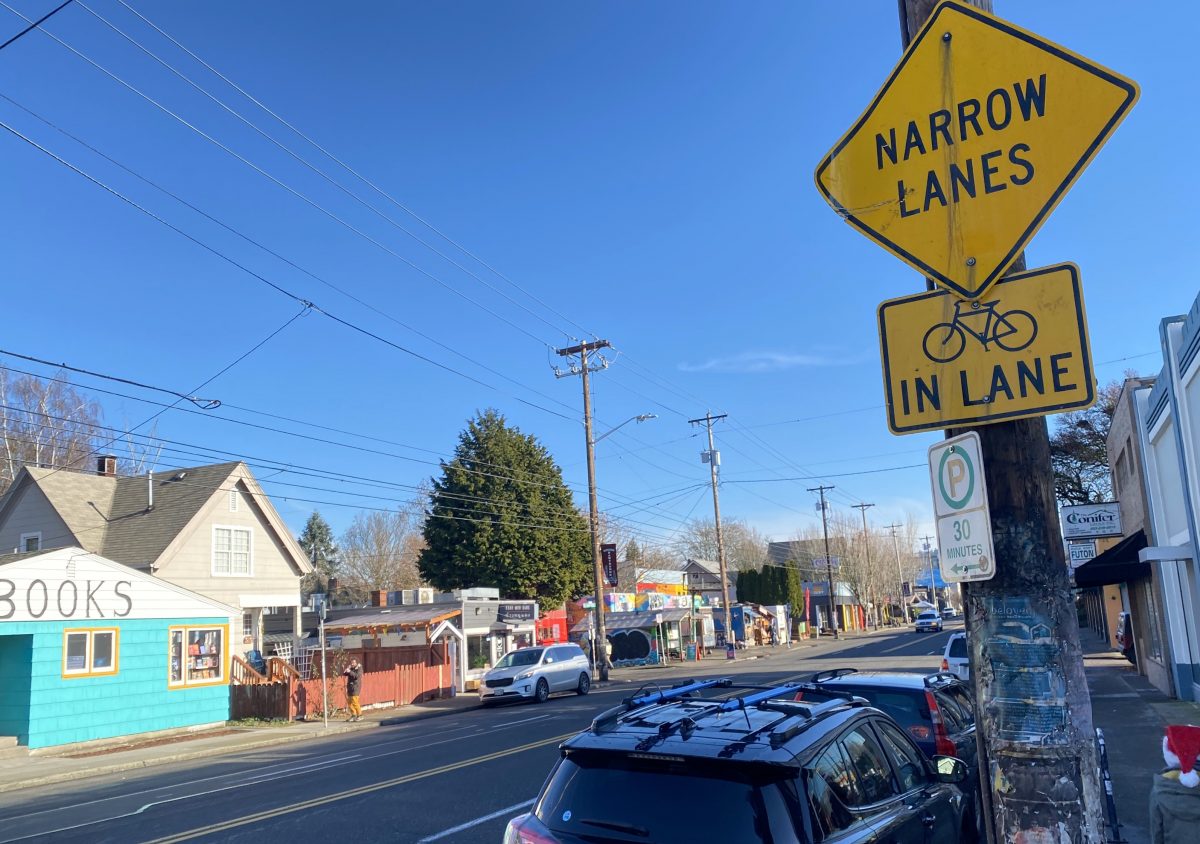
(Photo: Jonathan Maus/BikePortland)
Portland has a rare opportunity to create space for cycling on a dense, commercial section of Southeast Hawthorne Boulevard. We cannot afford to miss it.
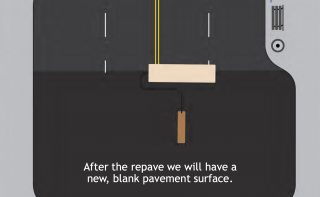
A paving project between SE 24th and 50th gives us a blank slate to create whatever type of street we want. And that’s not my opinion: Our transportation bureau themselves has said new pavement, “provides an opportunity to consider changes to improve safety, comfort, and function for people and businesses.”
So it begs the question: What kind of street should Portland create on this empty canvas? What type of street should we expect our elected leaders and city planners to provide on one of the most popular walking and shopping destinations in the entire city?
Do we want to invite more humane mobility choices that build community health and wealth and open up our streets for more types of people and users of all ages? Or do we want to encourage more toxic, dangerous choices that reduce access and continue the unsustainable status quo?
Zoom out a bit. Close your eyes and take a breath, then come back to those questions.
Advertisement
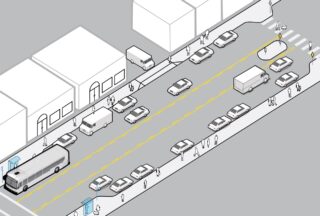
Now, how does it feel knowing that the striping option (at right) that scored highest in the Portland Bureau of Transportation’s initial evaluation would replace the current five drivable lanes on Hawthorne with five more drivable lanes on Hawthorne? How does it sit with you that we arrived at an idea to replace 52-feet of street space currently used for parking and driving cars with 52-feet for parking and driving cars?
It seems unbelievable. Yet while we currently find ourselves in this position, it’s not where we have to end up.
Right now, leadership and staff inside Portland City Hall and the transportation bureau are hovering over a more complete evaluation that tells them how various striping plans will impact traffic. They’re also very likely having discussions about how their decision will impact personal careers, public perception, media coverage and politics. I understand doing something different — like adding cycling space to a major commercial street in Portland — is scary. Anyone who’s served in government knows it’s always easier to make safe decisions. But given what Portlanders deserve and what these times demand, safe decisions might be easy but they won’t lead to the outcomes we desparately need.
It’s time for us to do something different — yet something that should feel very familiar if you believe in the visions we’ve already adopted.
Let’s zoom out again…
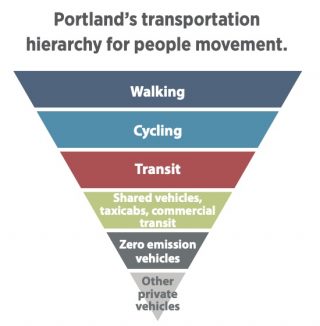
10 years ago when we passed the Portland Bicycle Plan for 2030, I would never have thought the talented and dedicated staff at PBOT (many of whom I think of as “advocrats” for their passion and willingness to push the limits) would be directed by their transportation commissioner (who was Chloe Eudaly at the time) to take a blank slate on Hawthorne and choose to continue to encourage and prioritize car and truck drivers. Yet that’s what they were told to do back in September.
This, from a city that once unanimously adopted the visionary statement below (taken from the Portland Bicycle Plan for 2030):
“It’s the year 2030 and Portland looks much different than it did a generation ago. By sharply reducing reliance on personal auto use, Portland significantly lowered its carbon footprint, eased traffic congestion, improved air quality and enhanced public health. One of the community’s most valuable assets, the public right of way was reclaimed for all Portland residents… Children, women immigrants, seniors and other populations that have historically not bicycled in large numbers now bicycle in higher proportions than ever before… With more money in their pockets and circulating in the local economy due to reduced transportation costs, the business community has come to embrace bicycling as a hallmark of the Portland region.”
And this from a city whose Transportation System Plan includes the “Transportation strategy for people movement,” (policy 9.6) that includes a prioritization of modes in an ordered list. Walking is first, then cycling, transit, taxis/TNCs, ZEVs, then in last place “other private vehicles.”
I have never stopped believing in these visions and I know we can achieve them.
Thankfully, PBOT is taking a second look at the Hawthorne project. This time around they’re under the direction of a new transportation commissioner, Jo Ann Hardesty, a leader who has a clear vision to create streets where, “People can access food and goods and services that are not tied to getting into automobiles”.
Advertisement
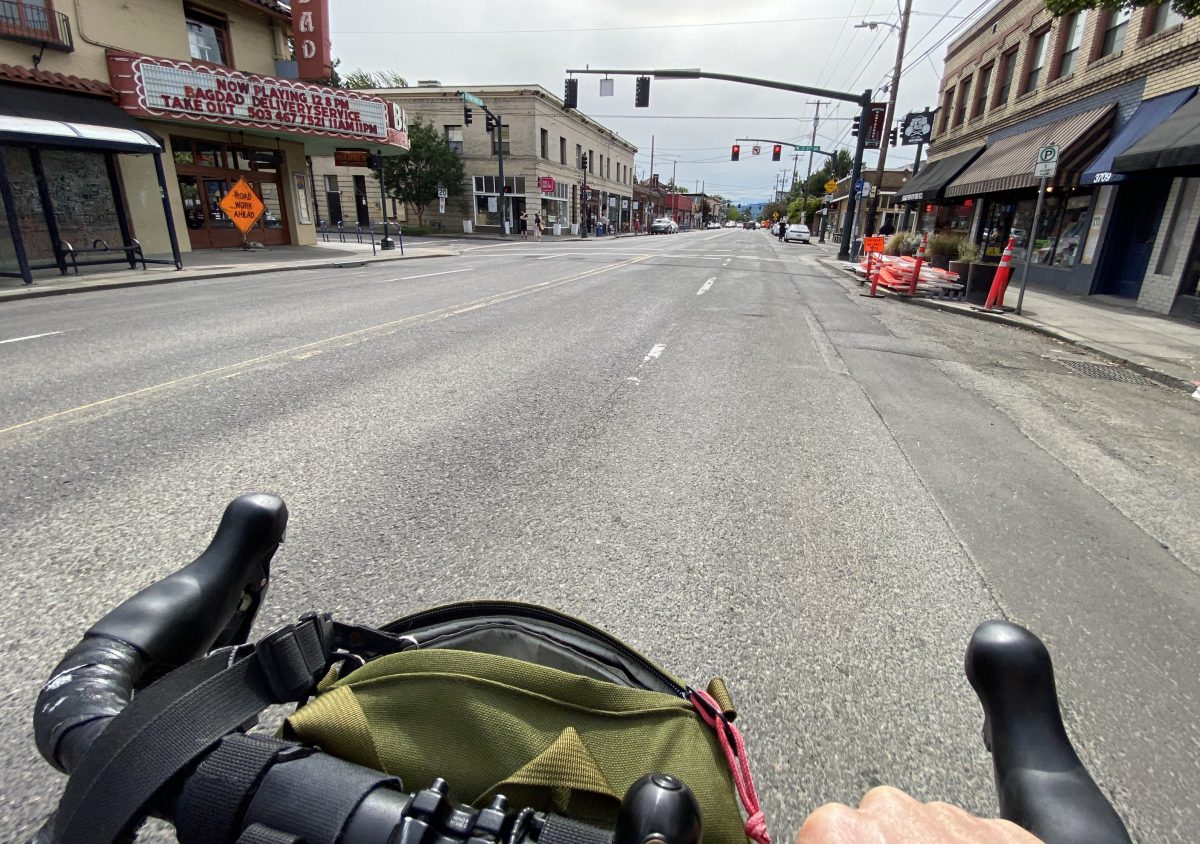
I understand that the potential safety implications of this looming choice are weighing heavily on influential hearts and minds. The models tell them having a center turn lane for the length of the project (Alternative 2 in the first evaluation, which would simply extend the current conditions east of Calle Cesar Chavez all the way west to 20th) would result in fewer “turning movement crashes” and “improve safety for pedestrians.”
“Safety” is a very tricky metric for making decisions, especially when derived from flawed and incomplete models. We absolutely need to protect people, but the altar of safety can paralyze us, cloud our larger vision, and make us less safe in the long run. Portland’s vision is to create streets that have more bikes, fewer cars, and to reap the myriad benefits that will follow.
And let’s not forget: A city with fewer people driving is much safer. As our traffic death toll and the horrific events of January 25th reminded us, every time someone chooses to drive a huge steel vehicle near vulnerable humans our collective risk goes up. To be truly safe, we need to take every opportunity to limit exposure to driving.
We should not bend our vision to fit a limited view of safety; we should create a new vision of safety. And if we look hard enough, the answers will be staring us in the face.
If you want to share your thoughts with the person who will decide the fate of Hawthorne Boulevard, she can be reached at joann@portlandoregon.gov.
— Jonathan Maus: (503) 706-8804, @jonathan_maus on Twitter and jonathan@bikeportland.org
— Get our headlines delivered to your inbox.
— Support this independent community media outlet with a one-time contribution or monthly subscription.


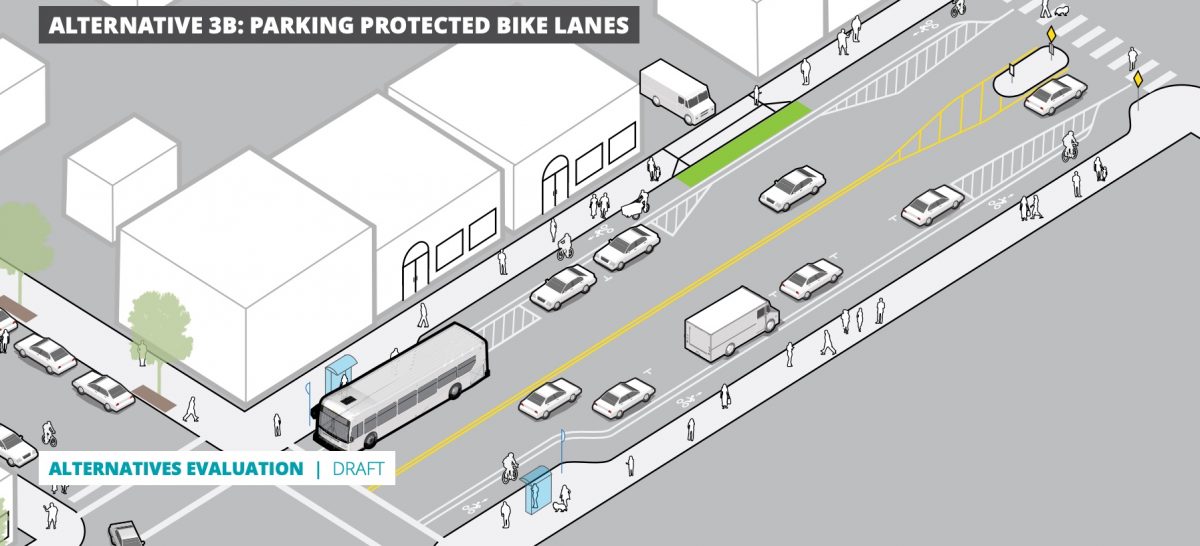
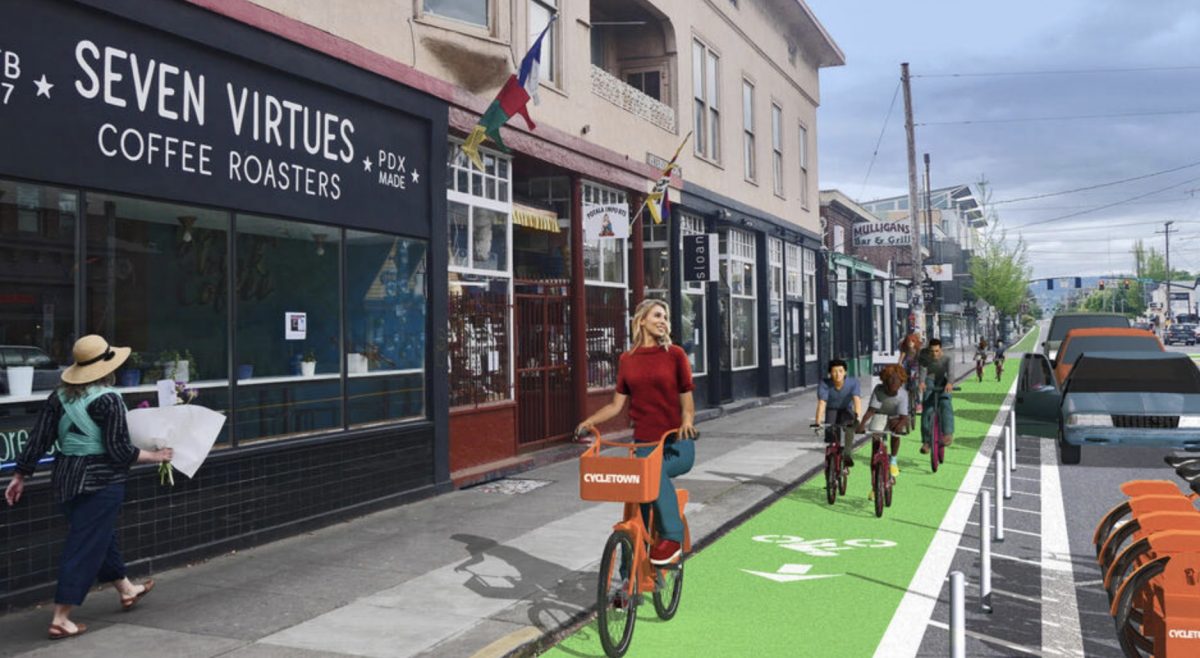
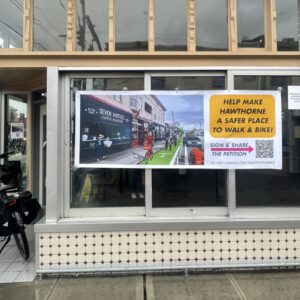
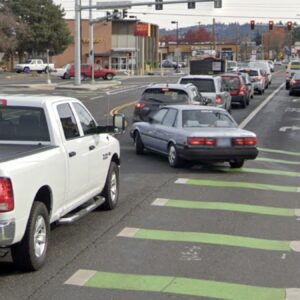
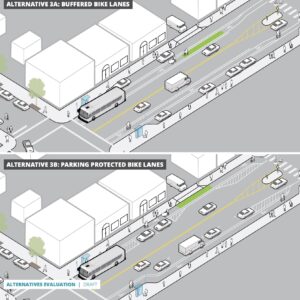
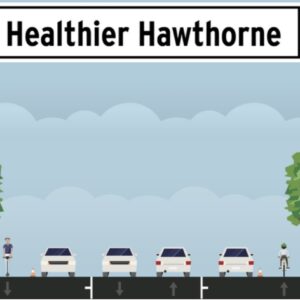
Thanks for reading.
BikePortland has served this community with independent community journalism since 2005. We rely on subscriptions from readers like you to survive. Your financial support is vital in keeping this valuable resource alive and well.
Please subscribe today to strengthen and expand our work.
The problem is that to do this RIGHT, you have to get rid of the parking (or signal every intersection). Parking-protected bike lanes with that much cross traffic at dozens of unsignaled intersections are just so many death traps (because the visibility is crap). To make parking-protected bike lanes safe, you practically HAVE to have signals with no-turns signaled bike phases. And I believe the door zone bike lanes have been picked apart enough already. I would love to see Hawthorne as a pedestrian- and bike-friendly utopia, but until they get rid of the parking (which I strongly suspect will never happen) I hate all of these plans.
Really great point nate. For the most part you may be correct. PBLs can be built 1) with minimal parking for delivery vehicles and protected intersections for high visibility and safer pedestrian crossings (as is the standard now in, for example, the Netherlands), or 2) with parked cars at all possible points and a merging lane at intersections (see Cully Blvd). The research on PBL intersections is clear. The latter is very unsafe, and it boggles the mind why PBoT chooses unsafe designs like Cully. But that doesn’t mean we should throw the baby out with the bathwater. I’ll take imperfect and poorly designed PBLs with the hope that PBoT can figure their shit out at some point. NYC finally did.
And of course they’ve already figured this out in Netherlands, Belgium, etc.
It’s complicated. One the one hand, we know what research on safe street design suggests. But we have a culture that prizes parking above all else. We also have a lot of people (cyclist included) who distrust “new” designs like protected intersections, or simply think having bike lanes are “nice’ but unnecessary (the rennrad, “get over it” crew). Engineers at PBoT likely know the constraints put on them would horrify a Dutch engineer. We also are biased toward a final build solution where everything must be “done” in the first go, which makes the stakes high for any project.
In reality, if our commissioners really had a good understanding of how poorly designed Portland streets are and what it’s like to bike in Portland, we would have long ago created interim projects on commercial streets to evaluate street changes longitudinally. God knows we have the advocates for it. We just haven’t had the leadership for so long.
If parking stays on business streets, it needs to become pay to park, with a good percentage of profits geared towards e panding more bike safety projects that connect from business area to business area. Right now it’s just islands of bike protected pathways surrounded by seas of shitty roads.
Agreed. I would argue all inner city neighborhoods should have paid parking, even people who live in the neighborhood should have to pay for a placard to park their car on the street. A network of PBLs is the singlemost important thing people who want safe streets can advocate for. It is the biggest predictor of modal share.
Here is a personal observation: I work near 11th/Hawthorne. I saw the video of shop owners supporting the bike lanes, and decided to take my boots to George’s to get repaired. I rode them up there on my lunch break on Friday. I took Salmon. I hsd planned to grab lunch on Hawthorne, too, but the sidewalk are too narrow to push a bike down to find a lunch spot, there was hardly any bike parking, and the drivers were pretty aggressive, so I bailed out, went back to Salmon, cut over to Ankeny, and got a sandwich from Slappys.
I’m stoked that the video inspired you to patronize George’s. That guy had such a great vibe.
This is an interesting comment. I’ve found the same thing about the sidewalks. Long ago, I had the thought that wider sidewalks might be the best thing for folks riding bikes to Hawthorne.
Having bicycling and other micromobility users have direct access along a corridor is a huge benefit for all involved. Its a no brainer and directly accomplishes Commissioner Hardesty’s goal to have more space in streets for non-auto users.
It saddens me to see alternatives 3a and 3b in the official report display false impacts on equity and transit delays. This should be addressed and updated on the site. Most of the public will see this and trust it point blank. However, Zach Katz did a great job providing clarity to PBOT’s analysis and why it is inaccurate and relates to a single thorn in the design: right-turn lanes at Cesar Chavez and that a mixing-zone was never considered with the bicycle lane users..
Its high-time to have a majority of people see non-auto use as a primary access for our business corridors and commute possibility for these dense areas. (Williams has many faults, but as a visible bikeway on the main business corridor its success is profound in the N Portland mode split). We shouldn’t be set aside a few blocks and tucked into neighborhoods for the convenience of auto-users and otherwise remain unseen.
“display false impacts on equity”
first of all, you offer no evidence at all for this blanket dismissal.
secondly, supporters of bike lanes have a long history of falsely claiming that impacts of equity are false or irrelevant. imo, this is one of the reasons that active transportation has become linked to white supremacy in portland.
“its success is profound in the N Portland mode split”
mode share has dropped precipitously in portland and according to pbot bike counts trips on williams have dropped almost 20% since the 2014 peak. ironically, the conventional bike lane on vancouver has higher bike counts overall suggesting that many are more comfortable on a “paint on the road” facility than on williams. (of course both are grossly sub-par facilities by international standards, just as any bike lane built on hawthorne would likely be a sub-par facility)
“Its high-time to have a majority of people see non-auto use as a primary access for our business corridors ”
without a laser focus on equity this often results in “carbon gentrification” (where lower-income folk who pollute the least are displaced to car-dependent suburbs). i believe it’s more important to decrease net emissions across the entire metro region, than to cater to the bougie needs of a minority of well-off super-emitters.
penntoday[dot]upenn.edu/news/when-green-fixes-actually-increase-carbon-footprint
onlinelibrary.wiley[dot]com/doi/abs/10.1111/1468-2427.12740
nic.cota,
I think misleading is more accurate than “false” when referring to the city’s analysis of equity and transit impacts with the bike lane alternatives. The city’s initial analysis was incomplete – something they themselves have admitted. That’s why further analysis is being done, to see if looking at different striping designs (a mixing zone where bicycle riders share space with other users at the Cesar Chavez intersection) will change those equity and climate impacts.
It’s false. PBOT is more than willing to lie to justify the plan they want.
Yeah, that may be right. Those scores are accurate to a bad design, and only a bad design, though. At the end of the day, the report is still up on the site and every minute people are being misled to think alt 3a and 3b are against equity and our climate. What a shame
Yes damage has been done by that analysis. I feel for PBOT in some ways. I like that they are taking a wider lens to these projects and we must consider impacts our decisions make on all users (not just bike riders). But I think that should be taken as a challenge that makes finding space for cycling more difficult, but not impossible, and not as another excuse for pushing bikes out of the picture yet again.
From the Hawthorne Pave and Paint Report:
“Alternative 2 offers the most benefit for bus travel time and reliability,…stop optimization along the corridor, providing left-turning vehicles places to turn without blocking the bus, and significantly reducing mirror strikes by providing standard-width travel lanes. With these changes, we expect average transit travel time to remain largely consistent before and after the project, but with greatly improved reliability, reducing the variability in travel time that can be a major impact to transit riders, which may deter people from riding transit in the first place”
Preserving mass transit throughput to Lents and Powellhurst-Gilbert is obviously a more equitable choice than slowing buses down to build a small disconnected stretch of sub-par bike lane.
apologies for not closing the tag.
Without clear vision of the future we are doomed to make the same mistakes of the past. Without changing our infrastructure dramatically we are dooming our future generations to a life of perpetual suffering through catastrophic climate change. The choices are clear: Build protected bike lanes, widen sidewalks, make public transit plentiful and get folks out of cars. This is our moment, let’s not squander it.
If Hawthorne gets two car lanes plus a center turn lane, I hope the car lanes are striped wide enough to put it in the running for a future streetcar corridor.
I like the protected bike lines. Maybe put bike racks instead of car parking at the intersections to address nate’s point about visibility (I assume the concern is right turns across a row of parked cars?) or maybe put down some concrete planters.
Once again, JM, you are giving your elected transportation commissioner far more “super-powers” than she or any of her predecessors ever had. You would be wise to inquire who within PBOT has final authority over the street design – who must ultimately sign-off on the project before it is restriped, and then focus your campaign on that person or persons.
This is a simple street repavement/resurfacing project. Potholes will be temporarily filled with patches of asphalt, then the old pavement will be ground down about 2 inches or so, the grooved roadway will sit with chalk striping for a few days, then a layer of new asphalt will be put in, then the new striping a few days later during mild weather.
And of course it’s the new striping we are discussing.
No new sidewalks, no new bioswales, maybe a fixed ramp here and there, possibly some new pedestrian islands, but nothing particularly major in construction.
Personally, I’d like to see a huge pedestrian plaza with the street open only from 2 am to 8 am, but otherwise bike and ped only, with marketing kiosks, outdoor cafe seating, and a playground. (But this being Portland, such an idea will soon have homeless camps.)
Hi David. Thanks for the input, although it comes off as sort of a
mansplainover-explanation of something I already understand quite well.The PBOT Commissioner, Jo Ann Hardesty, will be the final decision maker on this project. This is not just a repave, this is a political decision given Hawthorne’s high-profile status and the bike lane/no bike lane question that PBOT has agreed to consider. Yes, PBOT leaders will inform and influence Hardesty’s decision — but they will carry out her decision whatever it may be.
And I know this is just about striping. I’ve never said anything about hard infrastructure.
I like your idea of a huge plaza! Just illustrates how out-of-vision a car-centric plan would be!
Mansplaining? Are all women who are elected officials now “off limits”? That seems pretty sexist to me Jonathan. 🙂
He’s a man. Not sure I understand your comment.
Mansplaining is a pejorative. Sounded as if you were trying to minimize David’s comments re: Hardesty because he is a man. Sounds like I misunderstood but probably not a great word for the friendly lexicon. Cheers!
Mansplaining (a blend word of man and the informal form splaining of the gerund explaining) is a pejorative term meaning “(of a man) to comment on or explain something to a woman in a condescending, overconfident, and often inaccurate or oversimplified manner”.[1][2][3][4] Author Rebecca Solnit ascribed the phenomenon to a combination of “overconfidence and cluelessness”.[5] Lily Rothman, of The Atlantic, defined it as “explaining without regard to the fact that the explainee knows more than the explainer, often done by a man to a woman”.[6]
I think you may have just mansplained “mansplaining”.
Thanks Nadia. Point taken. I know exactly what “mansplain” means. I also know David personally so there’s more to this context than just a random comment interaction. I feel like his tone on here is often as someone who knows more than others (which is often the case… he does know a lot and has spent years in advocacy which I really admire and respect!). I was just sharing how his comment felt to me, and it felt a tad like a know-it-all. That’s is.
FWIW I changed it to a different word and will be more careful in the future. Thanks.
It’s a sexist put down. Why not use “overexplain” if putting down is really necessary, which, in this case, I think it wasn’t.
“Overexplain” I think does the trick nicely. Good job, team.
Exactly! And that one person is probably the Chief Engineer at PBOT, whoever that is now. When Rob Burchfield was in that position he nixed any sort of progressive changes on Hawthorne, if he’s still around I don’t see much hope for any substantial changes.
Plus, you will never get complete agreement on this from all stakeholders, and PBOT’s Chief Engineer will be the final arbiter of what gets built. IMO, if this goes anything like the last Hawthorne plan 20 years ago, don’t expect much.
16.10.200 Duties of the City Traffic Engineer.
(Amended by Ordinance Nos. 170923, 172976, 173369, 173627, 175205 and 182389, effective January 2, 2009.) The City Traffic Engineer will be designated by the Commissioner-In- Charge of the Bureau of Transportation. The City Traffic Engineer or his/her designee may exercise the following duties and responsibilities:
A. Implement ordinances, resolutions and directions of the City Council and orders of the Commissioner-In-Charge of the Bureau of Transportation by installing, removing, and altering traffic control devices.
B. Establish, remove, or alter traffic controls, including but not limited to:
1. crosswalks, traffic lanes, one-way streets, stop intersections or places, and no passing zones;
2. intersection channelization and areas where vehicle drivers may not make right, left, or U-turns, and the time when the prohibition applies;
3. parking areas and time limitations, including the form of permissible parking (e.g., parallel or diagonal);
4. regulated parking zones;
5. traffic control signals and any device that regulates a traffic control signal;
6. bicycle lanes and traffic controls for such facilities; and
7. other regulatory, warning, and guide signs.
C. Issue vehicle parking permits that authorize specified parking privilege.
D. Temporarily reserve portions of the street area according to regulations found in Section 16.20.500.
E. Issue vehicle permits for the movement of over dimensional vehicles on or over City streets.
F. Designate certain streets where certain classes of over dimensional vehicles may move on or over without a permit.
G. Designate streets where certain classes of vehicles may not move on or over except for local access.
H. Temporarily reduce speed limits when allowed by the provisions of ORS 810.180.
I. Designate certain streets as bridle paths and prohibit horses and animals on other streets.
J. Determine the location, design, and construction of streetlights.
K. Designate transit lanes and street locations where certain transit vehicles may proceed in a manner prohibited to other traffic.
L. Require the removal or pruning of any street tree, vegetation or other obstruction in the public right-of-way that obscures the visibility of or for drivers, bicyclists, or pedestrians, or in any way presents a safety hazard.
M. Regulate the installation and presence of banner signs on lighting poles owned by the City.
N. Install temporary traffic control devices when traffic conditions constitute a danger to the public.
O. Whenever specifically provided in the Title, the City Traffic Engineer may assess civil penalties for violations of the provisions of Title 16. The City Traffic Engineer shall adopt rules, procedures, and forms to be used in assessing such civil penalties. In determining the amount of any civil penalty to be assessed, the City Traffic Engineer shall consider the following criteria:
1. The extent and nature of the violation;
2. The benefits, financial or otherwise, accruing or likely to accrue as a result of the violations;
3. Whether the violations were repeated and continuous, or isolated and temporary;
4. The magnitude and seriousness of the violation;
5. The City’s cost of investigating the violation and correcting or attempting to correct the violation; and
6. Any other relevant factors.
P. The City Traffic Engineer’s assessment of civil penalties may be appealed to the Code Hearings Officer according to the provisions of Title 22 of the Portland City Code.
All the parking should be removed. Add one freight delivery parking per block on both sides during the day. At night allow residential parking in freight only spaces. I suggest people visit Hawthorne on Monday early am. Watch all the delivery drivers try to access New Seasons or any other restaurant. It’s a mess for those delivery drivers. Talk directly to the delivery drivers and ask them about what would work. Not the company owners.
That’s how to get resolution between businesses and bikers passing through. And yes, somebody at PBOT needs to stop association safe biking as being a racial equity issues in their policy documents. We aren’t asking everybody to ride a bike. It almost seems like someone inside PBOT is exploiting the dialogue on racial equity to pick a bone with cyclists and their safety.
Chris Warren needs to step up and be a leader, use your access and white privileges. Stop publishing policy documents that pit cyclists as contrary to social equity objectives. We are the solution, not the problem. RESPECT!!
Otherwise I’m a gonna have to block every new tax bill at the state level. Squeeze ODOT with the budgets.
Roberta,
In Portland the powers that be now always include “racial equity” as the reasoning behind a project. It’s the most effective way to shut down any criticism of a project. If you criticize it, you are against “racial equity” and therefore a racist. It’s the new way to for our leaders to shut down any constructive criticism.
Hey Nadia, I think we might all be able to agree that racial equity is a good long term ideal goal. The problem is how to operationalize it in concrete goals in a project such as Hawthorne. We know how nonsensically it was used in the prior analysis on Hawthorne, which was embarrassing for PBoT and Eudaly. But that may be more of a function of a failure to define it. It’s certainly a worth goal, but it’s not an easy thing to define concretely.
One possibility is that a paving project might not have a significant racial angle at all. That could be why trying to find something to “operationalize” is so difficult.
Removing all parking from a commerical district is a non-starter. Think whatever you want, but that will go nowhere.
Right. Whaat would people do without parking!? Probably chaos and anarchy.
Advocating for this project could also benefit the plight at the Alpenrose Velodrome. I noticed that the alignment goes along the north edge of the property. Has anyone thought about how to tie the two ideas together?
I think you commented on the wrong article…
Hi Nils,
Thanks for the comment… But yes as Momo says below it appears you intended to comment on the story prior to this one (about the Red Electric Trail). Hope you are doing well.
I mean personally I’d love to have a velodrome on Hawthorne.
“Walking is first, then cycling, transit… ”
transit should go first (and transit should be re-imagined and competitively funded so that tncs are no longer a viable alternative).
Maybe, but I think the hierarchy has something to do with the vulnerability of the user, right?
Yes, and independence. Cycling offers an unparalleled amount of independence compared to every other mode, even transit. That’s one of the main principles behind the Netherlands making cycling the #1 priority.
Someone will always chime in with “what about people with disabilities,” so preemptively:
Who else benefits from the Dutch cycling infrastructure: https://www.youtube.com/watch?v=xSGx3HSjKDo&ab_channel=BicycleDutch
10 Ways Bicycle-Friendly Streets Are Good for People Who Don’t Ride Bikes: https://www.aarp.org/livable-communities/getting-around/info-2016/why-bicycling-infrastructure-is-good-for-people-who-dont-ride-bikes.html
Those are nice ideas Soren. But that is not the policy.
Yes, in fact pedestrians are at the top of the hierarchy in our policies. But according to this opinion piece, concerns about pedestrian safety are portrayed in quotes, as if they are fake?
Curious if you intend to highlight the myriad of concerns that have been brought up in comment threads on this blog or just continue to only highlight the PBL option as the one that meets everyone’s needs. You could easily reach out to people already commenting on your page to expand upon their concerns that have been pretty broad, varied, and in depth.
In addition – this is a cost constrained paving project. This is not going to be an amazing PBL project. It’s going to be mediocre. I hope that doesn’t come at the expense of safety for other users for something that people will critique in the future because it doesn’t go far enough. This PBL will not allow for space for cyclists and mobility device users as portrayed in videos from the Netherlands. I am fully in support of a re-envisioned Hawthorne that includes REAL PBL’s and wider sidewalks, etc. etc. But this project is not where we can get everything we want. I encourage y’all (especially y’all that were skeptical of the transportation measure that dedicated MILLIONS toward active transportation but believe in this project as a holy grail) to support big visions that actually tie funding to the projects they propose.
Hey NM I hope we can both agree that safety should be the priority in design, which in our culture at least, is still something up for debate. I hope we can also agree that finding a dedicated funding source for projects that target safe walking and biking infrastructure is really important.
You may be correct. This project may end up being mediocre. PBoT does not have a good track record re: design even when all of the stars are aligned. Coming from a disability rights perspective, and having worked closely with people with autism etc. for a decade maybe, I look at most streets in the US and cringe. I don’t expect to assuage your concerns, primarily because I’m not exactly sure what they are. But I do hope that you consider how intertwined bike and pedestrian safety is. There is a bizarre bias in US culture where people often believe since someone has a few conjoined metal tubes, they are both dangerous and are also somehow protected from danger, and as such belong with multi-ton moving blocks. We need to find as much separated space as possible for people on bikes and walking.
I have learned to accept baby steps, because most people don’t care about safety until they know someone who has been killed or injured. This project may prove to be a baby step for Hawthorne. And their efforts won’t end with this project. A lot of people are willing to dedicate many hours of their day to making it safe for kids and old people who simply want get to the store/school. I hope you can join those people.
Hi NM,
Thank you for commenting. I really value your input.
That phrase is in quotes because it’s being attributed to a different source other than myself. I am absolutely not trying to marginalize them or say they are “fake”. Why on earth would you assume that? Are you really going to try and allege that I am against walkers? Really?
This is an opinion piece. I had thoughts about this project and so I shared them. That is it. This is one story of many. Have you read my other coverage? Why are you choosing to make these baseless insinuations about my motives that don’t align with my intentions or my record?
I have never said the protected bike lane option is the “only one that meets everyone’s needs.” I understand how claiming that helps you continue your false narrative about me and BikePortland, but it is baseless and untrue and it’s not a great way to engage at all.
I hope it will be better than mediocre but that’s a good point!
I also hope we can find space for bikes on Hawthorne that doesn’t come at the expense of safety for others. I disagree with you that lanes full of bike riders are inherently less safe than lanes full of car drivers.
And I’m not sure what your reference to The Netherlands is all about. I don’t think anyone has said we can expect a world-class cycle track on Hawthorne — although I guarantee you if we find some space for bikes now it will be much easier to envision and achieve that goal in the future!
I’m glad to hear this! But I think just because we can’t “get everything we want” isn’t a good reason to not ask for anything at all.
I’m not exactly sure what you are getting at here. I personally supported the Metro measure FWIW but I can assure you it would have had a much better chance of passing if it had more visionary “big vision” bike projects in it. And I agree that we need to have visions tied to lots more funding… But we also have to play with the hand we are dealt and I hope as an advocacy community we can work together on both immediate projects (like this one) while building toward larger visions (like a big funding package).
Jonathan, I am responding to this opinion piece because of a few factors: the safety measures being displayed in quotes (as a reader that came across as them being ‘alleged’ not at all explaining that they were information presented by traffic engineers and planners from PBOT), as well as the commentary of ‘the alter of safety’ keeping us from our vision while also focused on living up to our city’s policies with no discussion on pedestrians, only bicyclists, even though pedestrians are our city’s stated top priority. That is why I pointed these things out. I am not making baseless accusations or alleging you don’t care. I’m asking questions. I have read all of the coverage on this topic, and having it culminate in this opinion piece that only references the myriad concerns brought up (and backed up by alternatives presented by PBOT) as a couple ‘safety concerns’ in quotes feels frustrating.
Alternative proposals to the PBL on this specific paving project include benefits such as: reducing from 4 driving lanes to 2 driving lanes and a center turn lane to provide safer turning movements of vehicles for an extremely busy pedestrian street, as well as medians in the center turn lane that are wide enough to provide meaningful protection for people (not the minimum width), and improved crossings for peds and cyclists at the many intersection of neighborhood greenways that cross N/S. I guess I am feeling frustrated that anyone bringing up these benefits to pedestrians (and bikes!), or concerns about the PBL alternative impacting transit or limiting future sidewalk extensions is seen as supporting ‘nothing at all’. If the PBL gets built, I hope it is successful. I am not opposed to it – but for any project to feel like a positive investment of time and energy we should be talking about the pros and cons ESPECIALLY from people who care about the outcome for vulnerable users and may see things slightly differently. These concerns are being portrayed by other readers here as not supporting safety or not caring about cyclists or bigger goals for this city/region/cycling as a whole, and I felt this opinion piece reiterated that perspective instead of people bringing up some reasonable thoughts and concerns.
My reference to the Netherlands is in reference to a comment from Zach (the leader of this campaign) earlier in this comment thread – sorry for conflating that into a response to you. As a longtime advocate the tone of this campaign is extremely off-putting, and my frustration with the response to concerns was put into one comment – not meant to all be directed at you personally.
Thanks for the response.
NM, I care about pedestrian safety. I actually used to sit on Portland’s Pedestrian Advisory Committee! The reasons I disagree with you boil down to:
1) Protected bike lanes do not equate to less pedestrian safety. Sure, they might mean a 6-foot median island instead of a 10-foot one, but as far as I can tell from my research in safe crossing designs, the difference in safety and perceived safety between these widths is extremely marginal—certainly not enough to make it worthwhile to discard cyclist/scooter/skateboard/micromobility safety entirely!
Additionally, there are many excellent ways to increase pedestrian safety that don’t involve a massive turn lane for cars. These include left turn calming (https://www.portland.gov/transportation/vision-zero/left-turn-calming), daylighting at intersections, speed humps, and pedestrianizing side streets to eliminate turning conflicts entirely, among other things.
Finally, by making the street less car-centric, protected bike lanes increase pedestrian comfort in general by making the street more pleasant, with a slower, more human pace.
2) You seem to think the PBL design would negatively impact transit, but PBOT’s own engineers have stated quite clearly that a design with mixing zones at Cesar Chavez would eliminate transit delays: https://www.healthierhawthorne.com/blog/equity-and-climate-why-pbots-alternatives-evaluation-report-is-misleading
Encouraging people to bike will get people out of their cars, which will also help speed up transit. Cars are the real thing delaying transit, and Hawthorne should eventually be a car-free busway. In the meantime, the Division treatment would work wonders in speeding up buses—stop consolidation, longer buses, shorter headways, all-door boarding, signal priority, etc. No turn lane required.
3) The PBL would not impact future sidewalk expansion in the slightest, because this project is just new paint on the street. When it’s time to build a wider sidewalk, we’ll simply expand the sidewalk and build a concrete bike lane on the outside of it—just like the *REAL* PBLs you mention that we both agree would be amazing.
Thanks NM. I appreciate your response.
I see how you’d have valid concerns about my coverage and I understand. I also know many people in this community make false assumptions about my motives and read all types of speculative things into what I write. This is a site primarily about biking – so I will often making biking my focus. That does mean biking is #1 priority. That only means a particular post is mostly about biking because that is the stylistic/editorial decision I’ve made to most effectively get my points across.
And you should always be careful about making assumptions about me/bikeportland. This is absolutely not a culmination of my coverage. This is one small opinion piece amid a bunch of previous coverage and more stories to come. Opinion pieces are not where you will see me reference all valid points and issues — think of them as improvisational moments in a musical piece where I riff and share thoughts in order to give the reader something compelling to consider.
To be clear I really like the point you are making in your comment! I want to make sure to give the non-bike lane options there due and I will try and not let this become a safe/unsafe dichotomy when thinking about alternatives 2 vs 3.
Let’s continue this back and forth. The more debate we have the better the outcome will be. Thanks.
One likely future is that the TNCs become transit, but in a different form than today. I’m not advocating for that (I probably detest them more than you do), but it seems more probable than TriMet remaining viable once fleets of robot taxis arrive.
This part of town needs to do a better job helping the homeless community. Any plans of reconfiguring Hawthorne should also include appropriating some lots for camping spaces.
I think we need to move away from homeless camping. It’s not a good option to encourage for a multitude of reasons.
Yes but the problem is the inequity of the burden placed on some parts of the city. Particularly outer east PDX. Those folks were told to have compassion and be welcoming to their new homeless neighbors. But it’s a different story when it might be a blight on trendy shops and eating establishments.
You haven’t ventured much into inner SE if you think we haven’t been having to deal with it. It’s all over.
Yep, look at Laurelhurst Park area. A lot of million dollar plus homes with trash and drug needles scattered about. Yes, they were moved but came right back. A lot of people are seem to be pitting the “rich” against the “poor” neighborhoods but it is indeed all over and that division is not going to be helpful to any improvement. We need to fully fund basic shelters so everyone can be offered a roof. Then we can actually enforce no camping laws. Until the feds fund mental health services again and there is better drug treatment, little old Portland and their tired taxpayers are not going to be able to solve the homeless crisis. Portland cannot afford “wrap around services” for the entire region’s homeless. Just ain’t enough taxes you can get out of one city to pay for it.
Poor people to middle lower income bike far more than middle to high income bike tourists. Meaning…summer riders. Until portland solves the fact that poor people are moving out and rich people are moving in, bike counts will drop.
Hawthorne is a death trap. Great for cars and not much else. Too bad. It could be cool.and fun…but it’s just an alternative to 84.
This section of town is so bike rich that it’s almost privilege to be talking about it since there are literally greenways that surround it. Meanwhile, in the rest of town we have terrible lighting, no sidewalks, plenty of bike lanes filled with garbage. Which ones you may ask? Powell, Foster, Division, 122nd, and 162nd. I can’t help to think this is more privileged Portland getting more while the underserved get less to nothing.
Many of the business owners on Hawthorne live in outer East Portland. By welcoming bikes onto Hawthorne, we increase their sales and they prosper. Everything’s connected.
That promise can only be kept if more new customers arrive by bike than existing customers who drive stop coming because parking is a hassle.
That is the calculus merchants will be thinking about, and it would probably be helpful if you can find some convincing evidence that what you say is based on more than the wishful thinking it sounds like. For every hardcore rider like myself (who already ride to Hawthorne regardless), there are several fair weather riders who prefer driving in the drizzly months, or after dark, or when they’re taking a date downtown for a movie after dinner, or just when they’re tired and don’t feel like riding a couple of miles to get a taco. And for ever one of those, there are dozens and dozens who will never ride regardless.
I don’t see where the increased sales are going to come from. I hope the merchants do.
https://ppms.trec.pdx.edu/media/project_files/OTREC-RR-12-15%20Final.pdf
https://nacto.org/docs/usdg/measuring_the_street_nyc_dot.pdf
https://cityobservatory.org/portlands-green-dividend/
https://ecocitiesemerging.org/bicycling-and-portlands-green-dividend/#:~:text=Portland's%20Green%20Dividend%20refers%20to,to%20spend%20on%20other%20things.
If I felt my livelihood depended on easy access to my shop for my existing customers, and I thought they predominantly drove to get there, these articles would not convince me. I would have to think that more people would start riding to Hawthorne than drive there now, and I’m just not seeing that happening. As Zach likes to point out, you need a continuous network to get people to ride, and this is only a piece. (You probably also need good weather, daylight, fitness, and interest in biking.) So when will cyclists start showing up? Your landlord won’t wait 10 years for the rest of the network to get built out so that more people start passing by.
Theoretically true, but there are tons of untested assertions that underlie that theory, including that people would rather work for 20 mins (each way) than spend a dollar to by whisked there by car. Make Hawthorne hard to access, and maybe your customers will go elsewhere. Maybe not, but would you bet your livelihood on it? You’re probably better off at the blackjack table.
Ultimately, I don’t need to be convinced. But people way more conservative with way more on the line do.
In addition to the studies Steven provided, I encourage you to watch this video I made, which shows you how badly people wish they could ride on Hawthorne if only it were safe (and this was just in the span of two hours I spent filming on one corner!): https://www.youtube.com/watch?v=1BmsM959p6Y&feature=youtu.be
Parking IS a hassle. A sample size of one, but I’d be much more willing to visit Hawthorne with direct bike access than I am now.
I don’t personally shop on Hawthorne for a variety of reasons- 1) my locked bike would never be left in the street. 2) parking blows 3) Woodstock is better
I think a cure or treatment for COVID or support from the state/feds would make those shop owners happy. Also, I don’t think how their customers show up to their shops, as long as they do is what matter to them. I did watch you video, the ratios leaned heavily in children who don’t drive and also use protected lanes to know whether they work or not. Let them feel the blindly turning right hook in between streets and they may change their minds. Of course, I wouldn’t wish that on anyone but from personal experience, the pipe dream of protected lanes in the US is a funny one. I personally avoid streets that have them as the “protective “ idea is just that. Like I said, this area is bike rich,
These people that mysteriously own shops on Hawthorne yet live in deep east county should know better to not stand up for their mostly poor infrastructure In front of their houses and celebrate actions being done elsewhere. That really doesn’t make sense Zach. I applaud your efforts but it’s easy to plead for
More on Hawthorne than it is on 162nd.
@Doug: If redoing the street essentially costs nothing (since the underlying repair work has to happen regardless of how the street is ultimately striped), why is it so unfair? Would it be better to keep the street as it is, dangerous and dysfunctional, just so it won’t be better than 122nd?
Equity only benefits society when it raises people up; when it pushes people down, not as much.
In Portland there’s a $1 Billion Plus backlog of city streets that need resurfacing, according to PBOT. It will be decades, if ever, before PBOT catches up. There are worse streets than Hawthorne, streets that need to be torn up and completely rebuilt plus those that are simply in worse shape. There are lots of other streets that aren’t so bad, but a fix now will prevent a more costly rebuild later on. Likely there are many miles of streets in Portland needing the same kind of love Hawthorne will soon get, in the same bad shape, but given limited funding those other streets for various reasons weren’t selected this year. And quite likely many of those unselected and unloved streets were in poorer parts of town; and of course some may have been in richer parts of town too.
What isn’t being shown here is how streets have been selected this year to get PBOT’s attention. Are some streets loved more than others? Who made that selection, why, and what were their biases?
I hope we don’t go down the “restorative justice” via street repaving rabbit hole. If this approach continues we will need an equity analysis report and public comment before we can fill a pothole. How about fixing the worst and busiest streets first and not overthink it?
Hawthorne is a perfect outline for the roselane project. Remove the parking, have a car lane and bus only lane in both direction all the way to 50th. I never used unfair. But a simple gander at the bike map shows what exactly is around in terms of what people are asking for in bike lanes- they call them greenways. As Roger Geller puts them, bike freeways. Should buses have the same opportunity? Not everyone can bike, but they most certainly go by bus. Isn’t this equity?
Take a minute to look again at the bike map from a different perspective. Those greenways are car lanes with some paint marks. Where can someone bike safely on separated infrastructure with their family in SE? Look at the purple lines. Try to imagine if cars had the same network. Portland has attempted to sell people on greenways for decades because it is politically palatable: they cost little, and do not affect parking or car capacity.
That perspective is fundamentally flawed. Streets should be looked at as prioritizing space to 1) people 2) people on bikes and 3) if there is space, cars. The space we dedicate to each mode tells us what modal share we will get. Dedicate 99% of space to cars, and 99% of people will drive.
If you only consider car roads that are unshared with other modes, the auto network looks pretty sparse as well.
Far more than 5% of streets are open to and safe and pleasant for cycling, yet our mode share isn’t much higher. Your analysis is missing something.
“If you only consider car roads that are unshared with other modes, the auto network looks pretty sparse as well.”
Your point is nonsensical. Modes do not interact equally or “share” space equally. There is a bike lane on Portland Boulevard, but I would never actually ride it. “Open and safe” is very subjective. Kids can be easily killed on residential streets in a 20mph zone. The most predictable variable in modal share is a network of separated space for bikes. Until that network gets built, modal share will stagnate.
While you are right that kids can be killed on a 20MPH street, they rarely are, and I do not agree that greenways should be counted only in the “car infrastructure” column.
The network you describe will not be built in your or my lifetime, so if that’s what it will take to increase ridership, maybe it’s time to focus an issue where we can have an impact?
HK, that network certainly can be built quickly. PBoT could easily use paint, flower planters, and bollards to build a network of separated bike lanes on 11th/12th, East Broadway/Weidler, Williams/Vancouver etc. for a fraction of the cost of, for example, the Halsey/Weidler couplet ($5.5 mil). It’s not a budgetary constraint, it is a political decision. It is very possible much of this build and maintenance could be crowdfunded since so many advocates want change and have seen only status quo for decades from PBoT (recent Hawthorne decision as exemplar).
I know it’s easy to forget that traffic on greenways is limited by design to have less interactions with people walking and rolling. Did I forget to mention that I walk, bike, and drive in Portland and driving Has continually become more difficult to do. I think you should celebrate that idea. At the same time, oddly, more and more people are dying. Why is that? I don’t think you or the pipedreamers at PBOT can answer that as seen by giving up on VZ, which should’ve been tabled long ago.
There are a lot of reasons why injuries and death are increasing (at a record in Portland since 1996 I believe). But the primary reason is pretty clear: we design streets for car capacity, speed and parking, not for safety. VZ in Helsinki and a lot of other places worked likely because they used research to identify safe street designs and implemented them. PBoT and the city council did a great job reporting on/identifying dangerous streets. But the vast majority of those streets remain the same to this day. Hawthorne is a great example of PBoT’s failed policy: design for cars, not safety.
The street network is the same or better now than it was 20 years ago. Something else accounts for the increased fatality rate.
Yes, most streets are nearly the same as 20 years ago (in Portland). In NYC they are vastly different. Cities have often promote walking and biking without actually redesigning streets for people. Other factors according to the GHSA report are distracted driving (eg increase cell use during driving) and increase use of heavier cars (eg SUVs), which increase the chance of ped death during a crash. Unsafe street design is the biggest factor.
I live near here, and happily ride the greenways to get around. Bike lanes on Hawthorne would be cool, if there is space, but I’m hoping buses and pedestrian safety get priority with any new striping project.
Maddy, there is space! Think about that assumption: space for cars always exists as default.
Speaking of 11th & Hawthorne, is it really the case that PBOT plans to rehab Hawthorne from the river to 11th/12th and from 50th to 24th (or 20th) but leave the weird narrow-lanes gap along Ladd’s Addition unaddressed? I don’t understand why they’d go to all the work of restriping (at a minimum) but leave a dangerous 8-block gap smack in the middle.
As it is, I have no idea how you’re “supposed” to go from EB on Hawthorne at 12th to the greenway on Salmon. As it’s signed, you have the option of going right, into Ladd’s Addition, and then up Harrison, or…get off your bike and walk north, I guess?
Anyway maybe this is a case of “we’ll get to that section later on” but I don’t know why they’d leave those narrow lanes — which no one likes, drivers, bicyclists or walkers — on such a short stretch unchanged.
Oops, that was meant to be a reply to maxD’s comment waaaaay up at the top.
I suppose in that scenario, if one’s not comfortable crossing lanes to get to the left, the safest bet would be to do that “Dutch left” rigamarole at 7th Avenue and take 7th to Salmon? Definitely not ideal, of course. And without some sort of signage/wayfinding, people are forced to just wing it, which isn’t exactly low stress.
I live in the neighborhood. Crossing feels much safer, and that makes for a meaningful improvement to quality of life. But, ultimately the noise and air pollution in hawthorn are unpleasant, and the cars drive too fast for me to feel comfortable. The intersection with Cesar Chavez is particularly awful (and gets unbearably hot in the summer). I really like the businesses in the Hawthorn neighborhood, but as a cyclist they might as well not exist, and as a pedestrian it doesn’t feel like an area I’d want to go to socialize.
A few of the restaurants have little tables set up on the sidewalk, but between the cramped narrow walkways, noisy traffic, and fumes of idling parked cars it’s hardly a prime destination for a romantic dinner date. Imagine the different world we could live in with the parking and center turn lane replaced with additional sidewalk space, greenery, and bike lanes